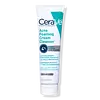What's inside
What's inside
 Key Ingredients
Key Ingredients

 Benefits
Benefits

 Concerns
Concerns

 Ingredients Side-by-side
Ingredients Side-by-side

Benzoyl Peroxide 4%
Water
Skin ConditioningGlycerin
HumectantPropylene Glycol
HumectantCocamidopropyl Hydroxysultaine
CleansingSodium C14-16 Olefin Sulfonate
CleansingXanthan Gum
EmulsifyingPotassium Hydroxide
BufferingCeramide NP
Skin ConditioningCeramide AP
Skin ConditioningCeramide EOP
Skin ConditioningCarbomer
Emulsion StabilisingNiacinamide
SmoothingGlycolic Acid
BufferingSodium Chloride
MaskingSodium Citrate
BufferingSodium Hyaluronate
HumectantSodium Lauroyl Lactylate
EmulsifyingSodium Hydroxide
BufferingCholesterol
EmollientPhenoxyethanol
PreservativePropanediol
SolventCitric Acid
BufferingTetrasodium EDTA
Diethylhexyl Sodium Sulfosuccinate
CleansingPhytosphingosine
Skin ConditioningEthylhexylglycerin
Skin ConditioningBenzoic Acid
MaskingBenzoyl Peroxide 4%, Water, Glycerin, Propylene Glycol, Cocamidopropyl Hydroxysultaine, Sodium C14-16 Olefin Sulfonate, Xanthan Gum, Potassium Hydroxide, Ceramide NP, Ceramide AP, Ceramide EOP, Carbomer, Niacinamide, Glycolic Acid, Sodium Chloride, Sodium Citrate, Sodium Hyaluronate, Sodium Lauroyl Lactylate, Sodium Hydroxide, Cholesterol, Phenoxyethanol, Propanediol, Citric Acid, Tetrasodium EDTA, Diethylhexyl Sodium Sulfosuccinate, Phytosphingosine, Ethylhexylglycerin, Benzoic Acid
Sulfur 10%
AntiseborrhoeicWater
Skin ConditioningKaolin
AbrasiveGlycerin
HumectantPentylene Glycol
Skin ConditioningCI 77891
Cosmetic ColorantMagnesium Aluminum Silicate
AbsorbentMicrocrystalline Cellulose
AbsorbentButylene Glycol
HumectantAvena Sativa Bran Extract
AbrasiveMelaleuca Alternifolia Leaf Oil
AntioxidantPhaeodactylum Tricornutum Extract
HumectantAlgin
MaskingNaringenin
Skin ConditioningSimethicone
EmollientHydroxypropyl Methylcellulose
Emulsion StabilisingSodium Acryloyldimethyltaurate/Vp Crosspolymer
Emulsion StabilisingAcrylates Copolymer
Mannitol
HumectantSilica
AbrasiveXanthan Gum
EmulsifyingAscorbyl Palmitate
AntioxidantPanthenyl Triacetate
Hydroxyphenyl Propamidobenzoic Acid
Skin ConditioningAluminum Hydroxide
EmollientCaprylic/Capric Glycerides
EmollientPolysorbate 20
EmulsifyingCI 77007
Cosmetic Colorant1,2-Hexanediol
Skin ConditioningHydroxyacetophenone
AntioxidantT-Butyl Alcohol
PerfumingPhenoxyethanol
PreservativeCI 77120
Cosmetic ColorantCI 77499
Cosmetic ColorantCI 73360
Cosmetic ColorantSulfur 10%, Water, Kaolin, Glycerin, Pentylene Glycol, CI 77891, Magnesium Aluminum Silicate, Microcrystalline Cellulose, Butylene Glycol, Avena Sativa Bran Extract, Melaleuca Alternifolia Leaf Oil, Phaeodactylum Tricornutum Extract, Algin, Naringenin, Simethicone, Hydroxypropyl Methylcellulose, Sodium Acryloyldimethyltaurate/Vp Crosspolymer, Acrylates Copolymer, Mannitol, Silica, Xanthan Gum, Ascorbyl Palmitate, Panthenyl Triacetate, Hydroxyphenyl Propamidobenzoic Acid, Aluminum Hydroxide, Caprylic/Capric Glycerides, Polysorbate 20, CI 77007, 1,2-Hexanediol, Hydroxyacetophenone, T-Butyl Alcohol, Phenoxyethanol, CI 77120, CI 77499, CI 73360
 Reviews
Reviews

Ingredients Explained
These ingredients are found in both products.
Ingredients higher up in an ingredient list are typically present in a larger amount.
Glycerin is already naturally found in your skin. It helps moisturize and protect your skin.
A study from 2016 found glycerin to be more effective as a humectant than AHAs and hyaluronic acid.
As a humectant, it helps the skin stay hydrated by pulling moisture to your skin. The low molecular weight of glycerin allows it to pull moisture into the deeper layers of your skin.
Hydrated skin improves your skin barrier; Your skin barrier helps protect against irritants and bacteria.
Glycerin has also been found to have antimicrobial and antiviral properties. Due to these properties, glycerin is often used in wound and burn treatments.
In cosmetics, glycerin is usually derived from plants such as soybean or palm. However, it can also be sourced from animals, such as tallow or animal fat.
This ingredient is organic, colorless, odorless, and non-toxic.
Glycerin is the name for this ingredient in American English. British English uses Glycerol/Glycerine.
Learn more about GlycerinPhenoxyethanol is a preservative that has germicide, antimicrobial, and aromatic properties. Studies show that phenoxyethanol can prevent microbial growth. By itself, it has a scent that is similar to that of a rose.
It's often used in formulations along with Caprylyl Glycol to preserve the shelf life of products.
Water. It's the most common cosmetic ingredient of all. You'll usually see it at the top of ingredient lists, meaning that it makes up the largest part of the product.
So why is it so popular? Water most often acts as a solvent - this means that it helps dissolve other ingredients into the formulation.
You'll also recognize water as that liquid we all need to stay alive. If you see this, drink a glass of water. Stay hydrated!
Learn more about WaterXanthan gum is used as a stabilizer and thickener within cosmetic products. It helps give products a sticky, thick feeling - preventing them from being too runny.
On the technical side of things, xanthan gum is a polysaccharide - a combination consisting of multiple sugar molecules bonded together.
Xanthan gum is a pretty common and great ingredient. It is a natural, non-toxic, non-irritating ingredient that is also commonly used in food products.
Learn more about Xanthan Gum